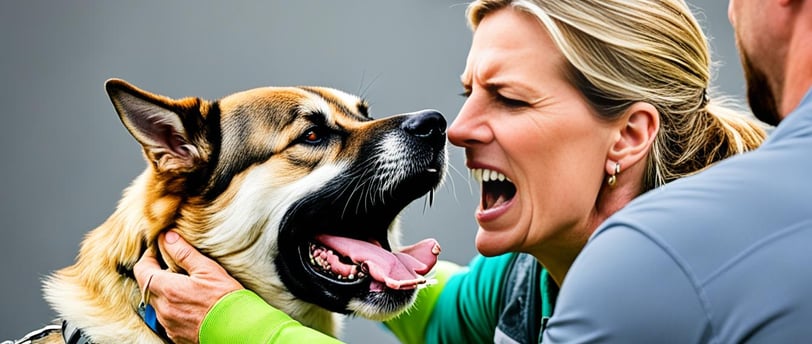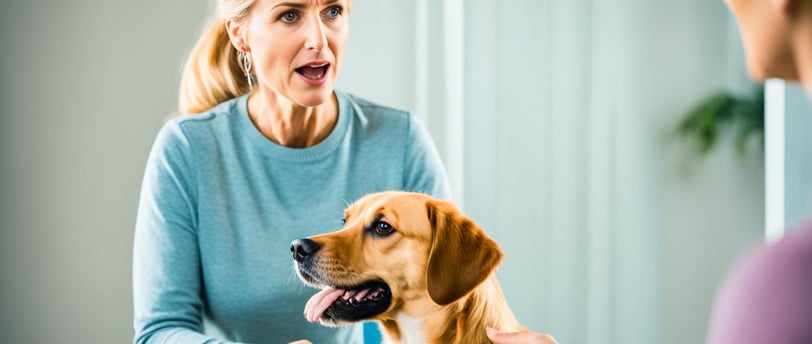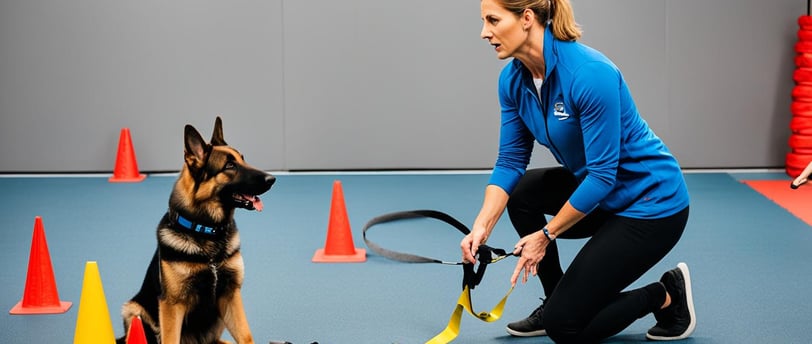Effective behavior modification for aggressive dogs
Discover effective behavior modification for aggressive dogs to address dog aggression in this comprehensive guide. Learn expert-backed strategies for managing behaviors like leash reactivity and resource guarding.
The Canine Chronicles
7/15/20246 min read


Imagine the shock and concern when my usually calm dog suddenly shows teeth and growls at a stranger during our walk.
This shows that dog aggression is serious and can be dangerous.
But, with the right aggressive dog training methods, we can help even the most spirited dogs become calm and friendly.
Learning how to train an aggressive dog is key.
It's not just about reacting to their bad behavior.
It's about taking steps before things get out of hand, using the right strategies, and being consistent.
By using aggression control in dog training, these dogs can become better friends and companions.
Proactive involvement and understanding of dog behavior are essential in mitigating aggression.
Dog aggression can escalate if not addressed promptly and with strategic interventions.
Sustainable behavior change requires consistent implementation of aggressive dog training methods.
Identifying the root causes of aggression is critical for effective training and behavior modification.
Professional guidance can be indispensable in tailoring aggression control techniques to individual dogs.
Understanding Canine Aggression and Early Warning Signs
Knowing the signs of aggression in dogs is more than just seeing a growl or snap. Look for signs like yawning, avoiding eye contact, and licking the nose. These can mean a dog is feeling stressed or getting ready to snap. Spotting these early can help you manage the situation with aggressive behavior management in dogs.
When these signs get worse, getting professional help for aggressive dogs is key. Experts can figure out why a dog is acting out, like fear or guarding its stuff. They create a plan to help the dog, making life safer for the dog and its owner.
Here are some early signs of aggression in dogs that owners should watch for:
Stiffening of the body
Direct, intense eye contact
Growling or snarling
Showing teeth or snapping
Lunging forward or charging at a person or another animal
Sign - Growling
Behavior - Low rumbling growl, possibly with bared teeth
Recommended Action - Seek professional help for aggressive dogs to assess situation
Sign - Snapping
Behavior - Quick, sharp movements towards a person or animal without contact
Recommended Action - Consult with a behaviorist for safe aggressive behavior management in dogs
Sign - Lunging
Behavior - Sudden movement towards a person or animal, with intent
Recommended Action - Immediate professional intervention to manage aggression
Knowing these early signs of aggression in dogs and acting fast can really cut down on aggressive behavior. Learning about these signs makes your home safer and helps you and your pet get along better.


Dog Training Techniques for Aggression: Professional Strategies
In my years of experience, I've learned that managing an aggressive dog takes a full approach. This includes talking to professional behavior experts, making sure your dog gets enough exercise, and using a specific behavior modification plan. Let's look at some good ways to train dogs with aggression.
Consulting with a Behavioral Expert
One key tip I suggest is to talk to a behavior expert. They can figure out why your dog is aggressive and make a plan to fix it. These experts use special methods that fit your dog's needs. This is key to seeing real changes.
Creating a Climate of Exercise and Stimulation
Exercise is key to reducing aggression in dogs. Dogs like terriers and working breeds need a lot of activity. But even calm dogs need enough to do. Giving them puzzles and toys that challenge their minds also helps. This stops aggression by keeping them from getting bored or frustrated.
Behavior Modification Programs
Changing your dog's behavior is the heart of dealing with aggression. Here are some methods that work well:
Habituation: Slowly getting the dog used to things that make them stressed.
Counterconditioning: Changing how the dog feels about things that trigger aggression.
Desensitization: Getting the dog used to the trigger in a safe way.
Positive Reinforcement: Rewarding the dog for calm and good behavior.
For very aggressive dogs, you might need to add medicine to the training plan, as a vet behaviorist suggests. Remember, being consistent and patient is important when using these methods.


Identifying and Managing Triggers in Aggressive Dogs
As someone deeply engaged in aggressive behavior management in dogs, I've learned how key it is to know what makes your dog act out. It could be other animals or certain things in their environment. Knowing what triggers their aggression is the first step to managing it well.
Here are some valuable tips for dealing with aggressive dogs: watch how your dog reacts in different situations. This can help you figure out what makes them aggressive. Then, you can work on reducing aggression with targeted actions.
Regular monitoring of body language for signs such as raised hackles or intense staring
Controlled exposure to known triggers under professional supervision
Immediate and calm intervention to divert attention when early signs of aggression are detected
Using these methods makes interactions safer and helps stop aggressive behaviors from getting worse in dogs.
Trigger - Presence of other dogs
Strategy - Controlled socialization exercises
Trigger - Loud noises
Strategy - Desensitization techniques
Trigger - Strangers approaching
Strategy - Positive reinforcement training
Managing a dog's aggressive behavior takes patience, consistency, and sometimes, help from a pro. By figuring out and understanding what triggers their aggression, you can make a safer, more peaceful space for you and your pet.
Conclusion
Throughout our discussion, we've seen that addressing dog aggression is complex. It starts with spotting signs of aggression early. This allows us to act fast. Each dog is different, so training must fit their specific needs.
Working with a behavior expert helps create a plan that suits your dog. They know how to tailor training to your dog's personality.
It's key to give dogs enough exercise and mental challenges. This keeps them healthy and reduces aggression. Adding behavior modification programs with positive rewards helps too. These programs teach good behaviors instead of bad ones.
Learning what sets off a dog's aggression is also vital. Managing these triggers can stop aggressive outbursts. This keeps everyone safe. With the right training, dogs can live happily and peacefully with others.
I hope the tips and advice given here help. They aim to guide you on the path to a better life with your dogs.
FAQ
What are some aggressive dog training methods?
Aggressive dog training methods include techniques like habituation and desensitization. They also use counterconditioning and positive reinforcement. These methods aim to reduce a dog's anxiety and aggression. They do this by gradually exposing the dog to triggers in a controlled way. They also reward calm, non-aggressive behavior.
How can I train my aggressive dog effectively?
Start by talking to a professional who can make a training plan for your dog. It's important to be consistent and patient with your training. You should also expose your dog to triggers in a controlled way. And, reward them for good behavior.
What does aggression control in dog training involve?
Aggression control means managing your dog's environment to prevent aggressive behavior. It also involves using behavior modification techniques. And, using positive reinforcement to encourage better behavior. It's about preventing the dog from practicing aggressive behavior.
How can I recognize early signs of aggression in my dog?
Look for early signs like stiffening, growling, showing teeth, or snapping. Also, watch for behaviors like excessive yawning, lip licking, and avoiding others. These can mean discomfort and may lead to aggression.
When should I seek professional help for my aggressive dog?
Get professional help if you see aggression signs, especially if you can't figure out the triggers. Or if the aggression is getting worse. A pro can help find the cause, make a plan, and teach you how to safely change your dog’s behavior.
What role does exercise play in managing a dog's aggression?
Exercise is key in managing aggression by burning off excess energy. It keeps a dog balanced, reduces boredom, and lowers stress that can lead to aggression. Regular physical and mental activities are important.
Can behavior modification programs help with dog aggression?
Yes, behavior modification programs can help with dog aggression. They aim to change how a dog reacts to certain things. This is done through techniques like desensitization, counterconditioning, and positive reinforcement.
What are some tips for dealing with aggressive dogs?
Stay calm and assertive when dealing with aggressive dogs. Avoid eye contact, which can be seen as a challenge. Give them space. Never punish aggression with aggression. Work with a pro to learn training strategies and use safety tools like leashes or muzzles.
How can I identify what triggers my dog's aggression?
Watch your dog in different situations to see when they get aggressive. Triggers can be other animals, people, sounds, or situations that upset them. A pro can help you spot these triggers and make a plan to deal with them.
Are there effective aggression training techniques for dogs?
Yes, there are effective ways to train dogs with aggression. These include consistent, positive reinforcement, clear boundaries, controlled exposure to triggers, and managing the environment. A holistic approach that looks at the dog's physical and emotional health can also help.
Source Links
Thanks and best regards
The Canine Chronicles
Click the link below and strat brain training for your pet today!
Click here for Brain training for your dog!
This post may contain affiliate links. If you make a purchase through one of these links, we may earn a small commission at no additional cost to you. We only recommend products and services that we have personally used and believe will add value to our readers. Your support helps us continue to provide valuable content. Thank you for your support!
